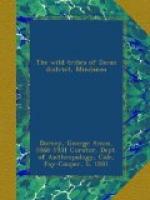OTHER BRANCHES OF THE TRIBE.
To the south and southwest of Mt. Apo, and west of Digos, are seven settlements, the inhabitants of which are known as Obo or Tigdapaya. On the south they meet the Bila-an, and, like this latter people, extend over the watershed into the valley of the Cotabato river. On the northwest they come in contact with the Ata. They have intermarried with both of these tribes, have adopted many of their customs, and in some cases their manner of dress. However, they consider themselves, and are considered by the Bagobo, as a part of that tribe, and recognize Tongkaling as their chief. Bagobo customs and blood predominate, although intermarriage with the Negrito was evident in nearly every individual of this division seen by the writer.
Immediately wrest of Daliao are three villages whose people are known as Eto or Ata. Aside from a slightly greater percentage of individuals showing negroid features, these people do not differ in any respect from the Bagobo. It does not seem that they should be classed with the people later referred to as Ata. To the north, their lands join the territory held by the Guianga.
The habitat of the division called Guianga begins a few miles back of the Gulf and extends west to the watershed. An east and west line drawn through the village of Taloma marks their southern boundary, while to the north they approach the Lasan river. They are found in a number of scattered settlements which owe allegiance and are subject to five petty datu. Tongkaling is not recognized as having any authority in the district, and there seems to be no remembrance of a time when any of the Bagobo rulers held authority over the Guianga. Physically and culturally they do not seem to be far removed from the Bagobo, while their language is so closely related that individuals of the two divisions, meeting for the first time can carry on a conversation. There is, however, considerable variation between the dialects, both in intonation and vocabulary.
Further study may result in raising this branch to the dignity of a tribe, but the information at hand does not justify us in considering them other than a dialect group of the Bagobo.
II. BILA-AN.
SYNONYMS.
(a) TAGALAGAD—“dwellers in the back country” is the name generally applied to this tribe by the coast natives.
(b) TAGKOGON—“dwellers in the cogon”—The group living on the grass plains west of Malalag.
(c) BULUAN, BULUANES—The members of this tribe dwelling near to Lake Buluan. This group is sometimes identified with the Tagabili or Tagabulu who also reside in that region.
(d) BIRA-AN, BARA-AN—Synonym for BILA-AN, often used by the neighboring Bagobo.
(e) VILANES, BILANES.
(f) BALUD or TUMANAO—name sometimes applied by early writers to the Bila-an who live on the Sarangani Islands.




